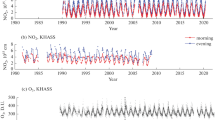Abstract
The column amounts of nitrogen dioxide (NO2) and ozone (O3) were measured using a visible spectrometer based on the twilight zenith-sky technique at two observatories located at similar latitudes in the northern part of Japan separated by a distance of 150 km. The measurements began in April 1991 at the Moshiri Observatory (44.4°N, 142.3°E) and in April 1994 at the Rikubetsu Observatory (43.5°N, 143.8°E). Since weather conditions and the possible influence from tropospheric pollution were not always identical at these two observatories, the overall accuracy of the measurements was studied comparing these data sets. The first year data obtained at a solar zenith angle of 90 degrees indicated that the NO2 slant column values at sunrise and sunset agreed within 0.36 and 0.54 × 1016 cm-2, respectively, corresponding to 5 % (June) and to 12 % (December) of the columns. The O3 values agreed within 0.76 × 1019 cm-2, corresponding to 4 % (March) ∼6 % (August) of the columns, although a part of the difference was systematic. The O3 column amounts were also compared to those obtained by the Dobson spectrometer at Sapporo (43.5°N, 143.8°E), whose latitude is similar to these observatories. When an air mass factor of 17.5 was used, the two-year Moshiri vertical column values agreed with the Dobson direct sun values to within 15 Dobson Units, or 3 ∼ 6 % of the column. The difference between the two values was found to be due partly to the change in the air mass factor caused by seasonal and day-to-day changes in the shape of the O3 vertical profiles. These results confirm the reliability of the NO2 and O3 measurements by visible spectrometers at these sites for the Network for the Detection of Stratospheric Change (NDSC).
Similar content being viewed by others
References
Bowman, K.P., and Krueger, A., 1985: A global climatology of total ozone from the Nimbus 7 Total Ozone Mapping Spectrometer, J. Geophys. Res. 90, 7967–7976.
Fish, D.J., and Jones, R.L., 1995: Rotational Raman scattering and the ring effect in zenith-sky spectra, Geophys. Res. Lett. 22, 811–814.
Goldman, A., 1978: Theoretical Simulation of Solar Spectra in the Middle Ultraviolet and Visible for Atmospheric Trace Constituent Measurements, NASA Langley Report, Contract NSG 1405.
Grainger, J.F., and Ring, J., 1962: Anomalous Fraunhofer line profiles, Nature 193, 762.
Harder, J.W., Brault, J.W., Johnston, P.V., and Mount, G.H., 1997: Temperature dependent NO2 cross sections at high spectral resolution J. Geophys. Res. 102, 3861–3879.
Hofmann, D., et al., 1995: Intercomparison of UV/visible spectrometers for measurements of stratospheric NO2 for the Network for the Detection of Stratospheric Change, J. Geophys. Res. 100, 16,765–16,791.
Johnston, P.V., and McKenzie, R.L., 1989: NO2 observation at 45°S during the decrease phase of solar cycle 21, from 1980 to 1987, J. Geophys. Res. 94, 3473–3486.
Johnston, P.V., McKenzie, R.L., Keys, J.G., and Matthews, W.A., 1992: Observations of depleted stratospheric NO2 following the Pinatubo volcanic eruption, Geophys. Res. Lett. 19, 211–213.
Keating, G.M., Pitts, M.C., and Young, D.F., 1990: Ozone reference models for the middle atmosphere, Adv. Space Res. 10, 12(317)-(12)355.
Keys, J.G., and Gardiner, B.G., 1991: NO2 overnight decay and layer height at Halley Bay, Antarctica, Geophys. Res. Lett. 18, 665–668.
Koike, M., Kondo, Y., Matthews, W.A., Johnston, P.V., Yamazaki, K., 1993: Decrease of stratospheric NO2 at 44°N caused by Pinatubo volcanic aerosols, Geophys. Res. Lett. 20, 1975–1978.
Koike, M., Jones, N.B., Matthews, W.A., Johnston, P.V., McKenzie, R.L., Kinnison, D., and Rodriguez, J., 1994: Impact of Pinatubo aerosols on the partitioning between NO2 and HNO3, Geophys. Res. Lett. 21, 597–600.
Kondo, Y., Matthews, W.A., Solomon, S., Koike, M., Hayashi, M., Yamazaki, K., Nakajima, H., and Tsukui, K., 1994: Ground based measurements of column amounts of NO2 over Syowa station, Antarctica, J. Geophys. Res. 99, 14,535–14,548.
Krueger, A.J., and Minzner, R.A., 1976: A mid-latitude ozone model for the 1976 U.S. standard atmosphere, J. Geophys. Res. 81, 4477–4481.
McKenzie, R.L., and Johnston, P.V., 1983: Stratospheric ozone observations simultaneous with NO2 at 45 °S, Geophys. Res. Lett. 10, 337–340.
Mount, G.H., Sanders, R.W., Schmeltekopf, A.L., and Solomon, S., 1987: Visible spectroscopy at McMurdo Station, Antarctica: 1. Overview and daily variations of NO2 and O3, Austral spring 1986, J. Geophys. Res. 92, 8320–8328.
Noxon, J.F., Whipple, Jr., E.C., and Hyde, R.S., 1979: Stratospheric NO2: 1. Observational method and behavior at mid-latitude, J. Geophys. Res. 84, 5047–5065.
Perliski, L.M., and Solomon, S., 1992, Radiative influences of Pinatubo volcanic aerosols on twilight observations of NO2 column abundances, Geophys. Res. Lett. 19, 1923–1926.
Perliski, L.M., and Solomon, S., 1993: On the evaluation of air mass factors for atmospheric near-ultraviolet and visible absorption spectroscopy, J. Geophys. Res. 98, 10,363–19,374.
Perner, D., Roth, A., and Klüpfel, T., 1994: Groundbased measurements of stratospheric OClO, NO2, and O3 at Sondre Stromfjord in winter 1991/92 Geophys. Res. Lett. 21, 1367–1370.
Pommereau, J.P., and Goutail, F., 1988: O3 and NO2 ground-based measurements by visible spectrometry during Arctic winter and spring 1988, Geophys. Res. Lett. 15, 891–894.
Sarkissian, A., Roscoe, H.K., Fish, D., Roozendael, M.V., Gil, M., Chen, H.B., Wang, P., Pommereau, J.P., and Lenoble, J., 1995a: Ozone and NO2 air-mass factors for zenith-sky spectrometers: Intercomparison of calculations with different radiative transfer models, Geophys. Res. Lett. 22, 1113–1116.
Sarkissian, A., Roscoe, H.K., and Fish, D.J., 1995b: Ozone measurements by zenithsky spectrometers: An evaluation of errors in air-mass factors calculated by radiative transfer models, J. Quant. Spectrosc, Radiat. Transfer 54, 471–480.
Solomon, S., Schmeltekopf, A.L., and Sanders, R.W., 1987: On the interpretation of zenith sky absorption measurements, J. Geophys. Res. 92, 8311–8319.
WMO Global ozone research and monitoring project rep. No. 16, Atmospheric ozone, World Meteorological Organization, 1985.
Author information
Authors and Affiliations
Rights and permissions
About this article
Cite this article
Koike, M., Kondo, Y., Matthews, W. et al. Assessment of the Uncertainties in the NO2 and O3 Measurements by Visible Spectrometers. Journal of Atmospheric Chemistry 32, 121–145 (1999). https://doi.org/10.1023/A:1006184628196
Issue Date:
DOI: https://doi.org/10.1023/A:1006184628196



